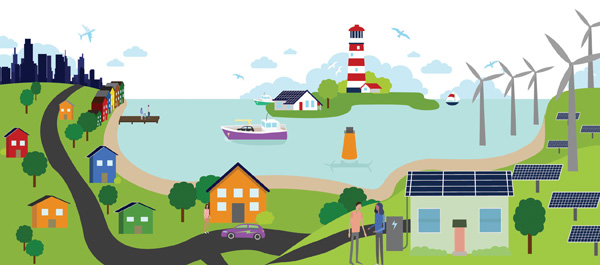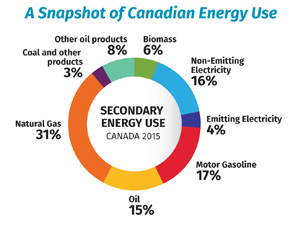 On June 7, following an extensive public consultation process, the Generation Energy Council released its report containing recommendations on how to achieve a low carbon energy future for Canada. More than 380,000 people participated in a wide ranging dialogue that was launched on April 21, 2017. Comments collected from the many participants were integrated into the final report, and the Council noted that several common themes were found, including the following:
On June 7, following an extensive public consultation process, the Generation Energy Council released its report containing recommendations on how to achieve a low carbon energy future for Canada. More than 380,000 people participated in a wide ranging dialogue that was launched on April 21, 2017. Comments collected from the many participants were integrated into the final report, and the Council noted that several common themes were found, including the following:
• Canadians want a clear energy vision for the future
• The path forward must be informed by collaboration with partners, Indigenous people, industry and Canadians
• The energy transition provides an opportunity for reconciliation with Indigenous peoples
• Canada’s diversity is a source of strength, bringing a broad range of skills, knowledge and expertise to meet the varied requirements of all Canadians
• Gender equality in Canada’s energy future is an important issue that deserves attention and action.
Saying that “It is important to continue to foster an inclusive dialogue on our energy future,” the report was formally presented to federal Minister of Natural Resources Jim Carr. The Council‘s mandate was to conduct “an open and inclusive nation-wide dialogue with stakeholders, experts and individual Canadians to envision what a low-carbon energy future would look like for Canada over the course of a generation:
• What should Canada’s energy future look like over the long term?
• What generational goals should we strive to achieve?
• What principles should guide us?
• What are the potential pathways and milestones along the way?”
Two examples of participant comments provide insight into the visionary range of advice the Council received.
Activist and economic and social theorist Jeremy Rifkin: With the plummeting price of solar and wind power, and their near-zero marginal cost, power companies in Europe and North America are now buying power in 20-year contracts in solar and wind at 4 cents/kWh. The big utilities in Germany are now producing 4% of renewable energy; the rest is coming from small cooperatives. For a while the big power companies are going to have to work in two portfolios – the legacy and the new, in which they provide services rather than base energy – to survive the transition. We’re going to have to patch up the second industrial revolution (electricity and fossil fuels) that we’re still working in, while preparing for the third industrial revolution (information, communication and artificial intelligence). The Internet of Things will be all the material things of the world, from buildings to refrigerators, turned into nodes with distributed intelligence and energy. Everyone will be able to produce their own energy in thirty years, it will be so cheap.
Politician and First Nations lawyer Senator Murray Sinclair: We have to change our relationship with the Earth. We have to change our relationship to those other elements of creation that are partners with us in life. In the traditions of First Nation traditions, there are teachings around how to use the bounty of the Earth. In the traditions of his First Nation ancestors, we can take the resources we need, but we have to do it in a respectful way. And in that way each generation has to do it in a way that makes it easier for the next generation. It’s a matter of bringing balance to the two perspectives. There might need to be, for example, a Department for Natural Resources (which also protects them, versus the department that merely assists in developing them).
How does mainstream society get the cooperation of First Nation communities for energy projects? “Don’t be afraid of it.” Don’t think of it as a veto power – the judiciary that interprets these things has always said it’s a question of balance, of acting in a reasonable way. We haven’t had enough of a conversation yet for that to move forward. It may not be the current generation in office that can do that, he suggested. That may be up to the next generation or two to do. But we can start generating the framework to do that.
 The answer to those questions at the beginning runs on two tracks, the Council decided: the rapid transformation of Canada’s energy production, distribution and consumption systems; and accelerated development of low-carbon technologies for use in the oil and gas sector “to reduce carbon pollution, cut costs, and create new value-added products and services.”
The answer to those questions at the beginning runs on two tracks, the Council decided: the rapid transformation of Canada’s energy production, distribution and consumption systems; and accelerated development of low-carbon technologies for use in the oil and gas sector “to reduce carbon pollution, cut costs, and create new value-added products and services.”
To illustrate, the report conducts virtual visits to four potential households of the future, from a small town on the east coast, to a mid-rise condo in a major city, to an Indigenous community in the north. Their common features are recognizable today, only more numerous:
• Transportation by electric ferries and buses, autonomous shared vehicles, as well as e-commuting.
• Net zero housing: well-insulated, with passive heating, heat pumps, rooftop solar, heat recovery from wastewater.
• Grid power has a large proportion of wind and solar, but includes nuclear and gas-fired cogeneration with carbon capture and reuse. That grid would meet over 50% of the province’s energy demand (up from 20% today), including still-burgeoning demand from EVs charging in the parking lot. Hybrid distribution systems, including microgrids, bring together an array of energy sources.
• An oil and gas sector with technology that turns waste carbon dioxide into feedstock for the concrete industry, a diversified product mix beyond fuel production.
• Utility regulations that have enabled utilities and their customers to take advantage of infrastructure, technologies and business models that integrate electricity production, conservation, storage and use.
• Smart investments guided by governmentally-targeted incentives.
The Council sees four basic pathways there: wasting less energy, electrification, increasing reliance on renewables, and producing cleaner oil and gas. Tools for getting there are also four-fold: regulations; conservation-focused financing, incentives, and other fiscal tools; and procurement and infrastructure guided by the first two principles.
The report makes special mention of Indigenous participation in all aspects of the energy transition: an ”upfront recognition of [their] rights, respect and cooperation,” improved regulatory systems with more formal roles in energy project decision making, assessment and review, ownership and management of energy systems, recognizing traditional knowledge and practices, engaging oncoming generations through education and training.
The report calls for an integrated Energy Transition Strategy and Plan informed by research, modelling, policy and indicator-tracking and by roadmaps for each of the four pathways—energy efficiency, clean electrification, renewable fuels, and producing cleaner oil and gas. It urges the federal government to establish an “independent, credible, evidence-based, transparent institute” for the purpose. A number of supporting tools are listed – expanding energy labelling, introducing new world-class building codes, integrating policies and regulations within and across jurisdictions, developing and attracting the needed talent.
“Our climate is changing rapidly,” the authors warn. “Unless we can start to reduce emissions now, we will soon have to grapple with the human and financial costs of more frequent and extreme storms, floods, heat waves, droughts and forest fires. The transition to a low-carbon economy necessary to overcome these challenges is a global race, and it won’t wait for us.”
The report is available at http://www.nrcan.gc.ca/20093.
